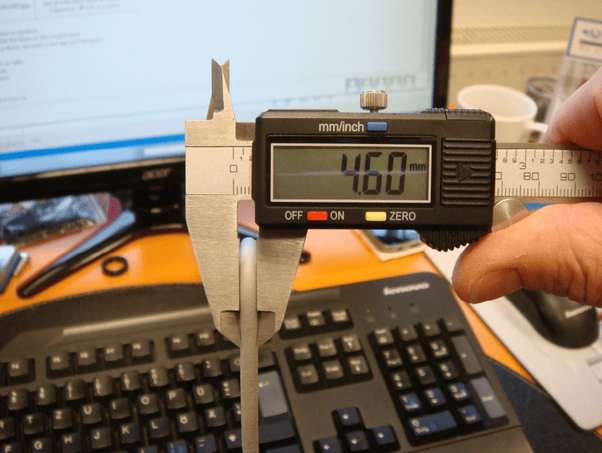Are you unsure how to measure rubber accurately? Whether it's for seals, gaskets, or custom rubber parts, knowing how to measure rubber size is essential for a proper fit and functionality.
Measuring rubber size is crucial for ensuring that rubber parts fit correctly and perform as expected. It involves measuring diameter, thickness, and length depending on the application.

Proper measurement of rubber components ensures the accuracy and efficiency of your applications, whether it's for sealing, cushioning, or vibration dampening. Let’s go through the key methods for measuring rubber and what factors to consider when determining size for your needs.
What Are the Key Measurements for Rubber Parts?
What measurements are essential when determining the size of rubber parts? You might need to know the key parameters for accurate sizing.
Key measurements for rubber parts include the outer diameter (OD), inner diameter (ID), thickness, and length. These dimensions ensure a proper fit for seals, gaskets, and other rubber components.
To measure rubber parts like seals, gaskets, or tubing, you’ll need to take a few essential measurements. These measurements can vary based on the type of rubber product, but the following are typically important:
Outer Diameter (OD)1: For round rubber parts such as hoses or seals, the outer diameter is one of the most important measurements. Use a caliper or micrometer to measure the diameter across the widest point.
Inner Diameter (ID)2: The inner diameter is vital for rubber tubing or gaskets that need to fit around other components. Again, a caliper is the most accurate tool for measuring ID.
Thickness3: For rubber sheets, seals, or gaskets, measuring the thickness is crucial for ensuring a proper seal or fit. Thickness is typically measured using a micrometer or caliper.
Length: For rubber hoses, strips, or cords, the length is the most important measurement. This can be done using a tape measure or ruler.
Circumference: For rubber parts like o-rings, measuring the circumference can help determine the correct size when the rubber is in a loop. The formula to calculate the circumference is:
*Circumference = π Diameter**
Summary of Rubber Measurements:
| Measurement | Application | Tool Used |
|---|---|---|
| Outer Diameter (OD) | Used for hoses, seals, o-rings | Caliper, micrometer |
| Inner Diameter (ID) | Used for tubing, gaskets | Caliper |
| Thickness | Used for seals, gaskets, sheets | Micrometer, caliper |
| Length | Used for hoses, strips, cords | Tape measure, ruler |
| Circumference | Used for o-rings, circular seals | Caliper, tape measure |
✅ Why it matters:
These measurements ensure that rubber parts will fit correctly and function as designed, preventing leaks, wear, and failure in applications.
What Is the Unit of Measurement for Rubber?
What units should you use when measuring rubber? You may be confused by the different systems used for rubber size and performance measurements.
The most common units of measurement for rubber are millimeters (mm) or inches for dimensions, while Shore hardness is typically measured in degrees (Shore A or Shore D).
When measuring rubber, different attributes require different units. Here are the common units used in rubber measurement:
Length/Dimensions: Rubber parts like hoses, seals, and sheets are commonly measured in millimeters (mm) or inches (in) for length, diameter, and thickness. For instance, the outer diameter (OD) of a rubber hose is typically given in millimeters or inches.
Hardness: Rubber hardness is measured using the Shore scale4. Shore A is commonly used for softer rubbers like seals and gaskets, while Shore D is used for harder rubbers. The hardness is measured using a durometer, which gives a numeric value based on indentation resistance.
Density: The density of rubber is usually measured in grams per cubic centimeter (g/cm³)5. It’s an important factor in determining how heavy or light the material will be and how it will perform under load.
Tensile Strength6: This is measured in megapascals (MPa) or pounds per square inch (psi) and is important for determining how much stress the rubber can withstand before breaking.
| Measurement Type | Unit of Measurement | Tool Used |
|---|---|---|
| Length/Dimensions | Millimeters (mm) or Inches (in) | Caliper, ruler, tape measure |
| Hardness | Shore A, Shore D | Durometer |
| Density | Grams per cubic centimeter (g/cm³) | Density tester |
| Tensile Strength | Megapascals (MPa) or psi | Tensile testing machine |
✅ Why it matters:
Using the correct unit of measurement ensures accurate rubber sizing and performance testing, helping ensure that your rubber parts meet the required specifications.
How to Measure Rubber Gaskets and Seals?
If you're measuring rubber gaskets or seals, you’ll need a bit more attention to detail. The right fit is crucial for maintaining a proper seal.
Measuring rubber gaskets and seals involves determining the inner diameter (ID), outer diameter (OD), and thickness. Accurate measurements are key to ensuring a proper seal and preventing leaks.

When measuring rubber gaskets or seals, it’s important to ensure that all dimensions are precise to avoid leakage or poor sealing performance. Follow these steps:
Measure the Inner Diameter (ID): This is the most important measurement for gaskets and seals that fit around pipes or other components. Measure across the inside of the gasket from one side to the other at the widest point.
Measure the Outer Diameter (OD): This measurement is essential for determining the fit around a pipe or flange. Measure across the outer edges of the gasket.
Measure the Thickness: Use a caliper or micrometer to measure the thickness of the gasket. This is essential for ensuring the right compression and pressure when the gasket is installed.
Measure the Shape: If the gasket or seal is not round, ensure to measure the full dimensions of the shape (e.g., square or rectangular) to confirm that it matches the required specifications.
| Gasket/Seal Measurement | What to Measure | How to Measure |
|---|---|---|
| Inner Diameter (ID) | Diameter of the hole in the center | Use a caliper |
| Outer Diameter (OD) | Diameter from edge to edge | Use a caliper |
| Thickness | Thickness of the material | Use a micrometer |
| Shape (if non-circular) | Length and width (if rectangular or custom shapes) | Use a ruler or tape measure |
✅ Why it matters:
Accurate measurements are essential to ensure proper sealing and prevent leaks in critical applications like HVAC systems, automotive, and industrial machinery.
How to Measure Rubber Tubing?
Are you dealing with rubber tubing and wondering how to measure it correctly? You’ll need to measure the inner diameter, outer diameter, and length.
Measuring rubber tubing requires the same basic steps: measuring the inner and outer diameters, and determining the length to ensure the tubing fits your application.

For rubber tubing, accuracy in diameter and length is key to ensuring proper flow and fit in systems like pumps, water lines, or automotive hoses. Here’s how to measure rubber tubing effectively:
Measure the Inner Diameter (ID): Measure the inside of the tubing using a caliper. This is important for determining how well the tubing will fit over or inside another component.
Measure the Outer Diameter (OD): Measure across the tubing at its widest point to ensure it fits properly within its housing or surrounding components.
Measure the Length: Rubber tubing is often purchased in pre-cut lengths or by the meter. Use a tape measure or ruler to measure the length accurately, especially if you need a custom-sized length.
Check for Consistency: For long tubing sections, ensure that the diameter is consistent throughout. If the tubing is kinked, deformed, or damaged, it may not perform as expected.
| Tubing Measurement | Application | Tool Used |
|---|---|---|
| Inner Diameter (ID) | Fit inside pipes, hoses | Caliper |
| Outer Diameter (OD) | Fit inside fittings or other components | Caliper |
| Length | Fit to the desired application length | Tape measure, ruler |
✅ Why it matters:
Correctly measured rubber tubing ensures proper fitment and function in fluid handling, transportation, or sealing applications, reducing the risk of failure or leaks.
How Do You Measure the Thickness of Rubber?
Measuring the thickness of rubber accurately is vital for ensuring that your rubber part provides the required seal or fit. Here’s how to do it properly.
The thickness of rubber is typically measured using a micrometer or caliper to ensure precision and avoid compromising the part's performance.
Measuring the thickness of rubber parts such as seals, gaskets, or rubber sheets is crucial, especially when dealing with parts that need to fit tightly or provide a secure seal. Here’s how you can measure the thickness effectively:
Using a Micrometer7: A micrometer is the most accurate tool for measuring the thickness of rubber. This tool provides precise readings to the hundredth of a millimeter or thousandth of an inch, ensuring an exact measurement.
Using a Caliper8: A caliper is another tool that can be used to measure the thickness of rubber. For rubber gaskets and seals, a digital or dial caliper will give a fairly accurate reading of the material’s thickness.
Multiple Measurements9: For materials like rubber sheets that may have uneven thickness, measure at several points to ensure the consistency of the thickness across the entire part.
| Measurement Tool | Accuracy Level | Application |
|---|---|---|
| Micrometer | High precision (0.01mm or 0.001in) | Thin seals, gaskets, sheets |
| Caliper | Moderate precision (0.02mm or 0.002in) | General purpose, thicker parts |
✅ Why it matters:
Accurate thickness measurements ensure that rubber parts provide the correct compression, seal integrity, and overall functionality in their respective applications.
How Is Rubber Density Measured?
Understanding rubber density is important when considering the material’s weight and performance. You might wonder how to measure this property.
Rubber density is typically measured in grams per cubic centimeter (g/cm³) and can be tested using a simple displacement method or using a density tester.

Density is a key property of rubber, indicating its mass per unit volume. Here’s how density is typically measured for rubber materials:
Using a Density Tester10: This instrument measures the mass of a rubber sample and divides it by the volume, usually calculated by placing the sample in a liquid of known density and measuring the displacement. This provides an accurate density reading.
Displacement Method11: For simpler testing, you can use the water displacement method. Submerge the rubber in a known volume of water and measure the volume displaced. From there, divide the mass of the rubber by the displaced volume to find the density.
Importance of Density12: A rubber material with a higher density typically has better abrasion resistance, more mass for mechanical load-bearing, and often a higher cost. Lighter rubbers are often used for applications where flexibility and ease of movement are essential.
| Method | Accuracy | Application |
|---|---|---|
| Density Tester | High precision | Industrial rubber, automotive parts |
| Displacement Method | Moderate precision | Quick tests, general rubber samples |
✅ Why it matters:
Measuring rubber density is important for determining the material’s suitability for certain applications. Higher density rubber offers better durability, while lighter rubbers may be more flexible and easier to work with.
Conclusion
Measuring rubber size correctly is essential to ensure proper fitment, performance, and longevity in your applications. Whether you are working with gaskets, seals, tubing, or custom rubber components, measuring the inner diameter, outer diameter, thickness, and length are the key parameters. Ensuring accurate dimensions prevents issues like leaks, improper sealing, and poor fit, leading to better product performance. Whether you're dealing with industrial seals, automotive components, or flexible tubing, proper measurement is crucial to the success of your project.
🚀 Need Custom Rubber Parts?
Contact Julong Rubber today or Request a Custom Quote to get precise rubber components tailored to your specifications!
Understanding how to accurately measure OD is crucial for ensuring proper fit and function of rubber components. ↩
Measuring ID correctly is essential for compatibility with other components, ensuring effective sealing and performance. ↩
Knowing the right tools for measuring thickness helps guarantee a proper fit and seal, preventing leaks and failures. ↩
Understanding the Shore scale is crucial for selecting the right rubber hardness for your applications, ensuring optimal performance. ↩
Exploring rubber density measurement helps in assessing material performance and weight, which is vital for design and engineering. ↩
Learning about tensile strength is essential for evaluating rubber durability and suitability for various applications. ↩
Explore this link to find the best micrometers that ensure precise measurements for rubber parts, enhancing your project accuracy. ↩
Discover tips on selecting the right caliper for rubber thickness measurements, ensuring reliable and accurate results for your applications. ↩
Learn why taking multiple measurements is crucial for consistency in rubber thickness, ensuring quality and performance in your projects. ↩
Explore this link to understand how a Density Tester works and its significance in accurately measuring rubber density, crucial for various applications. ↩
Learn about the Displacement Method, a practical approach for measuring rubber density, and its applications in quick testing scenarios. ↩
Discover why understanding the Importance of Density in rubber materials is vital for selecting the right type for specific applications, enhancing performance and durability. ↩







